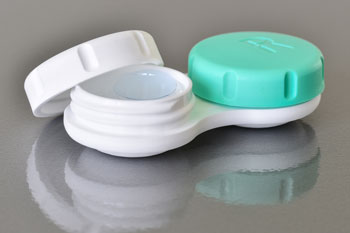We all have those patients, the ones that can make their contact lenses “stretch” for longer than they should; the ones that wear the trial pair they are fit with for five months or more before they go searching for more. Amazingly enough they never seem to have any negative results from this terrible practice. Inside we cringe while they tell us what they’ve done with a sense of pride at times. Their reasoning for doing this comes with multiple reasons and excuses: my lenses are still comfortable, I can’t afford more lenses, my insurance lapsed, and I can’t pay for an exam and lenses out of pocket, they just want my money, and the list goes on. Often they simply do not realize the risk they’re taking with their eyes and their vision. And the only way they will know is if we educate them in our offices.
For example:
- Corneal Ulcers. As stated in an Optometric Management article “A Sore Subject” from November 2015, “Non-compliance in contact lens wear is the biggest culprit for infectious corneal ulcers.”
- Giant Papillary Conjunctivitis (GPC): We regularly flip lids of patients in our office who admit to not being compliant with lens replacement. Most of the time we see at least trace irritation and red conjunctival tissue under slit lamp evaluation.
- Contact Lens Acute Red Eye (CLARE)

These are just a few of the complications of overwearing contact lenses; along with improper lens cleaning and handling as well as poor lid hygiene can cause our patients troublesome problems.
Not only do our patients hear about compliance with the wear and cleaning of their lenses from our doctors; they also hear it again when they come into my department to put on their new lenses. It’s especially important to work as a team when it comes to patient education; the patient needs to hear the same thing from the doctor as from the staff members.
We have multiple ways of imparting compliance education to our patients.
First is the modality of wear and what their non-compliance infraction may be. I educate them as to why lenses are different modalities: single use, two week, one month, or extended wear. I explain the whys about replacement frequency and why they should follow the manufacturers’ instruction. Over the years, I’ve learned a lot from our contact lens sales reps about why lenses should be replaced as directed. For example, a patient who was new to us was using single use lenses as an extended wear lens for weeks at a time. She had an ulcer on one eye when she came in to see us for her exam. The patient admitted she was not going to discontinue her extended wear habit. Once her ulcer healed we refit her in a lens designed for 30 day continuous wear, asking her to remove them once a week overnight to clean and disinfect her lenses. You will hear this phrase in our contact lens department frequently; “If you shower more than once a month, don’t you think you should clean your contacts more than once a month?” That phrase alone has sparked some pretty good Aha moments.

Second is lens and case care. Make sure you remind patients that they should be washing their hands not only for insertion but also when it’s time to remove their lenses at the end of the day. I am a big proponent of using brand name solutions,(my reasoning for that statement would require a whole other article.) I educate new wearers and patients who have worn lenses almost as long as I’ve been alive how to use their solutions properly. I remind them that they do indeed need to rub their lenses while using a multipurpose solution, just tossing them in the case is not effective enough cleaning to protect them from infection. They also need to rinse their case in hot water every morning along with rubbing their finger into the well of the case to dislodge the thin film that is present after the disinfection process is done. This habit prevents the patient from “topping off” their cases with the solution the next day, this practice greatly reduces the disinfecting capability of the solution. I tell patients they wouldn’t use the same dish water tonight as they did last night, so why do you do that to your eyes? We encourage frequent case replacement. Also, you just have to love when a patient pulls out their favorite 10 year old contact lens case. Their reasons for why the case is still good to run the gamut, with the most popular being, “but I run it through the dishwasher every couple months.” We offer new cases as often as possible to patients and encourage them to toss all of their old ones out.
Lastly, I always start out offering them an annual supply of contacts, not only does this make the patient feel less compelled to make their lenses stretch, so they don’t have to buy more, but it’s great for your office’s bottom line. There are so many ways to offer an annual supply to the patients with the range of rebates and discounts the manufacturers give. If they want to “shop around” for a better price I always tell them that while we’d rather they purchase them from us we really just want to make sure they purchase enough lenses to get through the year.
In closing, it’s not just the doctors’ responsibility to inform and educate the patients on compliance, it needs to be a team effort from start to finish. From the technician to the contact lens department and even in optical we can all do our part in meeting, not just our patients’ visual needs, but being a part of their health care team including the health of their eyes.

Michelle Carte, ABOC, NCLEC—Michelle Carte is the Contact lens Manager and Fitter at Southside Eyecare & Optical in Anchorage, AK. She began her career in the optical industry in 1994 working as an optician and doctors’ technician. She currently serves as the secretary for the Opticians Association of Alaska and has held this position for many years. Michelle is ABO and NCLE certified and is always in search of ways to better her knowledge in the optical field through education and leadership events.












